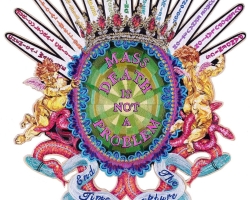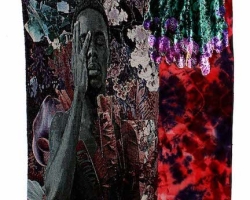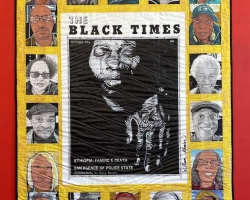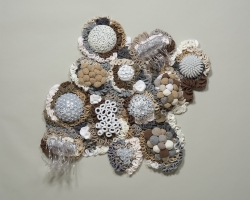Reliably strong red thread is a defining element in three of the pieces by William Rhodes. Inherited from his grandmother, the thread is heavy and durable, conveying a link of strength from generation to generation in the face of racial trauma and its legacy. Rhodes’ piece “Soldier” directly addresses the burning hatred perpetrated by the Ku Klux Klan. A hooded face glares out to the left of a cross framed with a wooden flame motif. Its counter is the image of a black woman in white and emblazoned with a red stitched cross, facing us on the right, a beacon of hope. “Harlem Rent Party” recalls the resilience and support of the community when its members, facing desperate circumstances, threw parties to raise money for rent, a reminder that there can be joy and support in facing tough times together. Also on display are two of Rhodes’ quilts. At the center of each is a powerful image, a call to face the pain and grief of poverty, desperation, and racial injustice in solidarity. “Revolution in Our Lifetime, ” created in collaboration with the former Black Panther Minister of Culture, Emory Douglas, features Douglas’ bold black-lined image of a people determined to forge ahead to claim their right to equality and justice. The cover of the 1974 issue of The Black Times, a magazine published by Rhodes’ father from 1968 to 1978, forms the centerpiece of another quilt, a mother deep in sorrow over the death of her child. Though the year was 1974, Rhodes painted this image because the circumstances of desperation and starvation remain ever familiar. Encircling these bold panels are portraits honoring the lives and contributions of members of Rhodes’ life and community, hand drawn and painted on fabric. Together they connect history to everyday people, calling future generations to take up the legacy of determination and resolute courage.
Robin L Bernstein‘s work courageously calls out complex and insidious subtexts of white supremacy and fascism masquerading as more benign movements, while also alerting to hidden, and not so hidden, threats. Dynamic cut shapes and enticing color invite the viewer into the pieces. At first they appear to be painted, one can see the swirling line work, but stepping up close, the elaborate threaded detail becomes evident. Hundreds and hundreds of pieces of thread and string have been pressed into wax creating a mesmerizing effect tactile effect. This sumptuous visual feast reverberates with our senses while leading to contemplation of the message at hand. In the immediate, “Defense of Nature” embraces wholesome ideas of environmentalism, a cause so many rally around today as the specter of climate change hangs on the horizon. One might not be aware of the underpinnings of white supremacy driving early ecological movements. It can be easy to align with the noble goal of preserving nature, without realizing some groups pin their ideology on white dominion over the earth. “L’Dor V’Dor, From Generation to Generation” likewise calls out the numerical signifiers of antisemitism and racism, coded symbols readily recognized by members of certain white supremacist organizations actively preparing to assume greater power. Bernstein asks us to be thoughtful and alert as we determine our response to the many demands for our attention involving important humanitarian actions. In contrast, “Depopulation” presents a glorious array of potential destruction. Rather than meet the future with denial, the work calls for recognition of those potentialities. Its sunburst structure might be read as rays of hope, inviting a personal commitment to consciously educate ourselves and move forward in even small every day actions, collectively making new decisions for a healthy and just society and planet.
Custom created tapestries and fabric conglomerations by Richard-Jonathan Nelson speak to another kind of courage and transformation, the bold expression of personal identity, in this case as a queer black man. Created by means of computer aided design, Nelson’s works invite a multilayered viewing. Vulnerability is on display as is bravery and the strength to openly reveal oneself and the nature of one’s longing. Sumptuous verdant foliage speaks to ideas of primitive nature. Carefully crafted bodies speak to expectations and desire. Tapestries featuring custom digital collage on Jacquard woven cotton, hand woven fabric, sumptuous color and detailed embellishments embody richness, while the casual pinning of work implies a sense of ease.
Rounding out the exhibition, abstract works by Ruth Tabancay incorporate plastics and disposable objects such as pandemic masks and styrofoam meat trays, with needle arts including hand embroidery and crochet. With a keen concern and alarm for the unknown outcome of our very unnatural interference, Tabancay’s work specifically references the changing environment especially under the onslaught of plastic waste. Plastics are now ubiquitous. Once vibrant coral reefs lie faded beneath the surface of the ocean, islands of plastic circulate on top. Drawing attention to this ever growing incursion, “Bleached” and “Plastic Reef” are rich with intricate and fulsome yarns and sensuous shapes. The soft forms are reminiscent of cushioning, relating to the reef’s cushioning of the coastlines, protecting them from storm erosion and providing an abundance of food for millions of people. Amidst this environmental onslaught scientists are now discovering bacteria and larvae that break down plastic. Interestingly, forms that emerge from certain embroidery stitches look remarkably like bacteria and fungal colonies. Tabancay explores ideas about utilizing and encouraging change at the level of direct bacterial intervention in “Adapting to New Substrates.” Continuing to raise awareness of the vital importance of our changing ocean ecologies, the work may inspire change for its viewers as well.
 Gallery Reception
Gallery Reception









